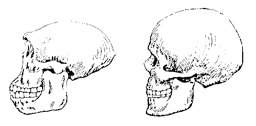 |
Science Frontiers ONLINE No. 89: Sep-Oct 1993 |
|
|
Homo erectus never existed!
 (Left) Homo erectus skull. (Right) Homo sapiens skull. Are these markedly different skulls representative of two different species or merely variants of the same species? |
"Reappraisal by Cornell University paleontologists of a 200,000-year-old skull from India's Narmada River suggests that the fossil was probably a Home sapiens -- not a Homo erectus -- and marks another spot of the globe where humans may have evolved. ....."The reappraisal of Narmada Man preceded the recently announced discovery of two Middle Pleistocene fossils from Yunxian, China, that seem to share the traits of Homo erectus and Homo sapiens. Kennedy would like to bury the taxon Homo erectus altogether, "Those who would like to keep the taxon see a 200,000year-old Narmada Man as a last gasp for Homo erectus," he said."
What will the anthropologists do now with all those skulls they labeled so confidently as Homo erectus? Actually, the possibility underscored by Narmada Man is that modern humans evolved almost simultaneously in several parts of the planet, not just in Africa.
(Anonymous; "Homo erectus Never Existed?" Geotimes, 37:11, October 1992.)
Reference. Human evolution and paleontological evidence are subjects covered in BHE in Biological Anomalies: Humans III. To order this catalog, visit: here.